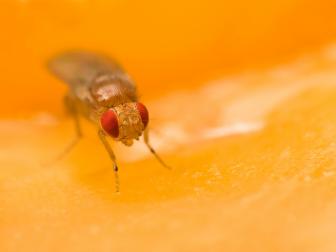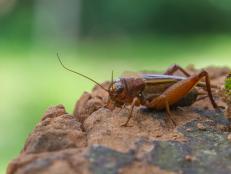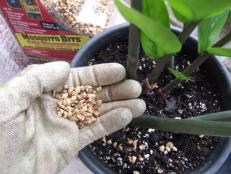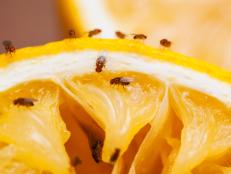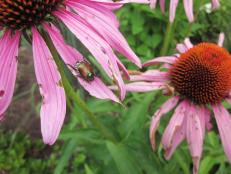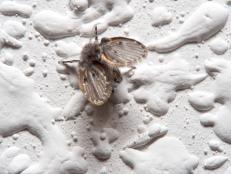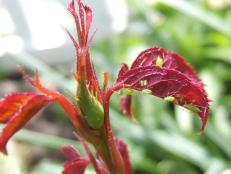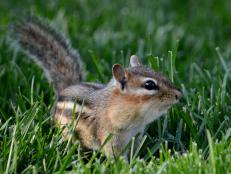How to Get Rid of Flies
Find out simple steps for how to get rid of flies, indoors and out from the garden experts at HGTV.
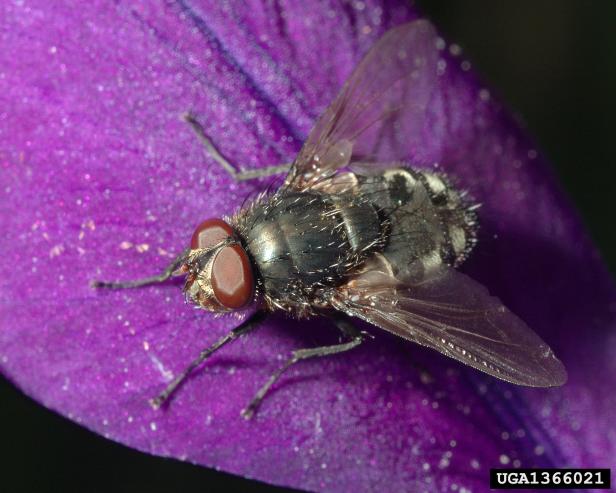
Susan Ellis/Bugwood.org
According to researchers at CalTech, the best way to hit a fly with a flyswatter is to aim just ahead of it, because it will move when it sees you coming.

What is a Fly, Anyway?
Researchers estimate there are more than 120,000 species of "true flies" around the world. These members of the Diptera order include houseflies, blowflies, crane flies, cluster flies and fruit flies, among others. Sometimes gnats and other small, flying insects are also referred to as flies.
Common Types of Flies
Houseflies are some of the most common flies. They're also known as filth flies because they feed and reproduce on garbage, and human and animal blood. They can carry disease and spread pathogens that cause dysentery, food poisoning and other serious health problems.
Fruit flies. Sometimes called vinegar flies, these pests with light brown or tan bodies and red eyes are among the smallest flies. They're drawn to overripe fruit, open containers of beer, vinegar and wine and damp and/or decaying organic matter.
Drain flies. Also called moth flies and filter flies, these insects frequent sink, shower and bathtub drains. They're also found near compost piles, storm drains, leaking or broken drainage pipes and areas with damp, decaying organic matter. They resemble tiny moths.
Humpbacked flies. Also known as phorid flies, these pests are also drawn to leaky plumbing pipes. Their larvae may feed on plants, too, as well as garbage and decaying organic matter. While they look similar to fruit flies, they don't have red eyes, and unlike fruit flies, which stay near a food source, humpbacked flies move around.
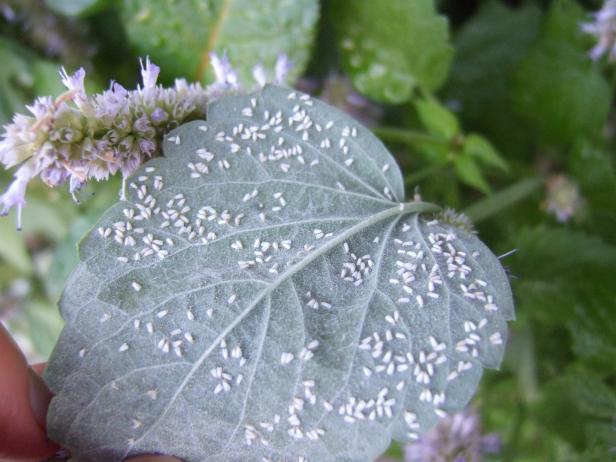
Julie Martens Forney
While whiteflies aren't true flies, they can weaken or kill garden plants and houseplants.
Whiteflies. Whiteflies aren't true flies. These pests are in the Hemiptera order. Because they hide under plant leaves, they're often hard to spot, but suspect them if you see white clouds of tiny insects around your plants. They also suck plant juices and leave behind a sticky substance called honeydew. In your garden, ladybugs and other natural predators will help control them, or you can use horticultural oils, soaps or bioinsecticides. Be sure to use a product labeled for indoor use when treating houseplants.
What to Do About Flies
"To best protect your home from flies, limit their access as much as possible by keeping doors and windows closed," says Glen Ramsey, technical services manager for Orkin and a certified entomologist. "Screen windows, doors and vents. Keep garbage cans clean and securely closed. Keeping other surfaces clean will also make your home less appealing to flies."
Banish Fruit Flies With This Tip
A Surprising Way to Banish Fruit Flies
Get rid of fruit flies by pouring them a nice glass of wine.
Identifying the type of fly you're dealing with is also key, he adds. Different species often require different control methods.
"The next step is to sanitize the area where the flies have been landing or potentially depositing their eggs." Female house flies lay eggs on trash or other decaying, organic materials. "If the breeding site isn't removed, the flies will continue to be a problem." The final step, he says, is to eliminate adult flies.
Insecticides that kill various kinds of flies are available as foggers, aerosols and baits. If you use sprays, be sure they are labeled for indoor, residential use and spray them around door frames, windows and other places flies can enter. Don't use them around children or pets or where children and pets eat, sleep or play. Read and follow all product directions.
If doors, vents and windows are already screened, check for any small holes or gaps and repair them.
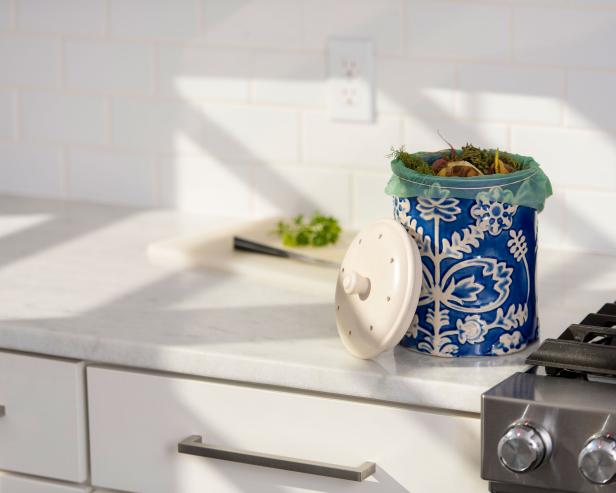
Gardeners Supply Company
Deter flies by keeping kitchen scraps in a lidded compost container, like this one from Gardener's Supply Company.
Keep foods and beverages covered and discard overripe or rotting fruits and vegetables. Wash food and liquid containers thoroughly after use, and toss disposable containers in an outdoor trash can.
If you're saving kitchen scraps to add to a compost pile, keep them in a lidded container. Decorative countertop styles are available; some have charcoal filters to help control odors.
Keep lids on indoor garbage cans and empty the cans often. Wash and disinfect them as needed.
After pets eat, wash their bowls and clean up around their eating area. Keep pet foods in sealed containers.
Hang sticky fly paper and fly tapes, but be careful where you place them. The sticky material can also grab onto your hair, clothing and other objects.
Try fly traps that use ultraviolet light and/or pheromones to lure and contain flies; they may be of limited help. Unfortunately, these fly "zappers" also kill many beneficial insects when placed outside. Follow the manufacturer's directions for use.
If drain flies or moth flies are a problem, clean your drains by scrubbing them or use a drain cleaner. Follow the product directions to avoid damaging your plumbing. To prevent the flies from returning, check around your home for water leaks and repair them.

Julie Martens Forney
Replenish your homemade fruit fly trap as needed and dispose of overripe fruits and veggies.
Make a baited trap for fruit flies by mixing a little sugar and apple cider vinegar with a few drops of dishwashing soap in a cup or saucer. Flies attracted to the odor will fall in and die.
Try premade fly traps. These often have a cone at the top and bait at the bottom. Different flies are drawn to different kinds of bait. For example, houseflies are drawn to sugar or yeast, while blowflies will visit traps baited with ammonium carbonate or a protein base.

Julie Martens Forney
Fungus gnats are attracted to houseplants when overwatering causes organic matter in the soil to decay.
Tiny flies that hover around overwatered houseplants are probably fungus gnats. Their larvae feed on decaying organic material in the soil. Let your plants dry out slightly between waterings and remove any decaying or rotting plant materials. If the gnats persist, use an insecticide labeled for fungus gnat control, such as Bacillus thuringiensis var. israelensis to kill the larvae and break the breeding cycle.
How to Control Flies Outdoors
Clean up animal waste from your yard, bag it, seal the bag and dispose of it in an outdoor trash can.
More Garden Pests
16 Common Garden Pests 45 Photos
Find out how to contend with garden pests including flies in this handy HGTV guide.
Watch to see where flies land and take off, and remove any wet or decaying organic materials where you suspect they are breeding. Look for areas of standing or stagnant water and drain them. If an area stays constantly wet, try to divert enough water to let it dry out.
Keep compost piles away from doors and windows. Use good composting practices so organic materials in the pile decompose safely and quickly.
Set up fans around picnic tables, grills and other outdoor areas to help deter flies from landing.
Use residual pesticides made for outdoor use on surfaces where flies land, such as on exterior walls. If you use a pesticide or trap labeled for outdoor use, keep it away from children, pets and wildlife.
For severe fly infestations, call a pest control professional.






